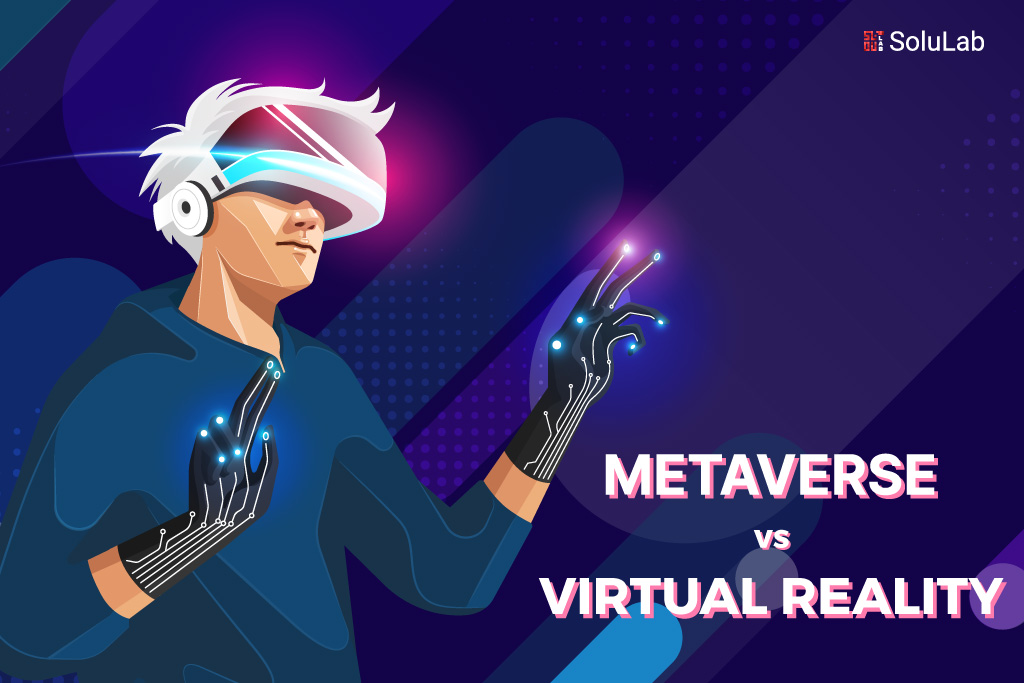Table of Contents
The Metaverse is a concept that encompasses multiple businesses – the whole industry. It’s also plausible to claim that the Metaverse is nothing more than a catchphrase for technical advancements in the present Internet.
Since the phrase “metaverse” became popular in October 2021, when Facebook announced its renaming to Meta in celebration of selling 10 million Oculus VR devices, it has typically been interpreted to imply “using the Internet in virtual reality.” This is an error.
Virtual reality (i.e., VR headsets) will be simply one method of accessing the Metaverse, and others argue that it will not even be the most essential.
Let us read on to have an in-depth knowledge of both concepts and a comparison of Metaverse vs virtual reality.
Defining Metaverse

Some of you might be listening to this term for the first time or must have heard it along with a comparison. Something like Metaverse vs virtual reality. However, it is not a term that has been introduced recently. You will learn about its origin by reading further.
But first, let us understand its meaning.
A metaverse is a forever-lasting 3D cosmos with an online presence that integrates many virtual places. Consider it a futuristic version of the Internet. Due to the Metaverse, users will be able to collaborate, socialise, play, and interact in these 3D environments.
From Where Did Metaverse Originate?
The term ‘metaverse’ was introduced by Neal Stephenson, an American writer. But where did he exactly use this term? He used it in a novel that was published in the year 1992. The name of the novel was Snow Crash, a dystopian cyberpunk novel!
Now, how does this novel explain the Metaverse? It explains this term as a 3D virtual world. Don’t think of it as some game. It is a virtual world that lasts forever. You can also call the Metaverse a universe where you share virtual spaces linked to each other, and you can teleport between them.
Did you know?… Neal brought a weird fact to Forbes’ notice in 2011. He said that he saw World of Warcraft as the actual Metaverse. A virtual world where you can stay with your mates. Playing games like Minecraft or Fortnite in 2021 could get us closer to his metaverse vision.
Metaverse Theoretically Explained!
Consider the Metaverse to be a product or service
In January 2020, author and investor Matthew Ball published the most widely used definition of the Metaverse: “an expansive network of persistent, real-time rendered 3D worlds and simulations that can be experienced synchronously by an effectively infinite number of users, each with an individual sense of presence.”
The Metaverse, according to his description, is a product or service with seven basic characteristics, including persistence, synchrony, and interoperability. However, technology expert Ben Thompson has suggested that this description is not dissimilar to what the Internet currently is and accomplishes, although “with a 3D overlay on top of it.”
The Metaverse as a location
The Metaverse has also been defined as a site where individuals may connect, engage, and move themselves and their stuff across numerous digital locales. Examples include gaming and creative platforms such as Roblox, Epic Games’ Fortnite, and Manticore Games’ Core, where gamers and their avatars may effortlessly shift from one virtual environment to another.
The Metaverse as a point in time
Shaan Puri, a startup entrepreneur, has proposed another description, characterising the Metaverse as a place in time. The Metaverse, in particular, is the point at which our digital lives — our online identities, experiences, connections, and possessions – become more important to us than our physical lives. This viewpoint emphasises the human experience, making a move to the Metaverse a societal rather than a technical one.
Opportunities Offered By Metaverse

Virtual communities, activities, and events are all available without logging into different applications.
A significant component of the Metaverse that will work in its favour for a user-centric approach is the seamless transition from one phase to the next without inconsistencies.
Signing into his virtual workplace as a virtual avatar of himself, seeing a customer, taking a break, or playing a sport – all in one spot – is possible.
With the Covid-19 epidemic limiting our ability to work outside our homes, the Metaverse takes it to a whole new level. It enables seamless cross-platform engagement with friends, family, and coworkers all across the globe.
Even in the game business, cross-platform interaction remains in its infancy. With the Metaverse, cross-platform interaction will be the gold standard for global virtual engagement. Addresses and pin codes will no longer be required.
The virtual marketplace will be a serious commercial concern with the Metaverse.
Instead of the intrusive pop-ups and forced adverts prevalent today, brands will turn their advertising into a memorable experience.
Isn't the Metaverse supposed to be a virtual world?
If you’re thinking about the Metaverse vs virtual reality argument, doubts like these are almost certain to arise. There are many virtual worlds in the Metaverse, not just one. On the contrary, it will be a virtual world alongside the actual world. It’s possible to get answers to this issue by looking at the Metaverse as a distinct idea from internet technology.
In the Metaverse, you’d be more than simply a machine that requests information from online servers. Using digital avatars, Metaverse users may access online material and virtual places. As a virtual avatar, users may engage in various experiences in the Metaverse. To put it simply, the Metaverse may be described as a large, shared virtual environment where there are no limitations. Let us take an example. When you visit a virtual museum in the Metaverse, you don’t have to log out of a game.
Will the Metaverse eventually replace the Internet?
Many individuals had thought that virtual reality would have a greater influence on our world. Unfortunately, there is a time restriction on how long individuals are willing to use headphones. The Metaverse will be unaffected by this problem and will be available to those who have and do not have access to a VR headset. Some feel it will have a greater effect. However, the Metaverse is unlikely to replace the Internet. VR headsets provide an intriguing alternative to computer displays. The Metaverse is a fascinating alternative to the Internet. But is the “Metaverse” just a rebranded version of Virtual Reality?
When Mark Zuckerberg mentions the Metaverse, he attempts to brand the virtual world. With the Facebook Oculus VR headgear, it’s more than simply playing games or running social apps: it’s entering the Metaverse!
In a 2017 interview with Vanity Fair, Stephenson made the point, arguing that VR (virtual reality) rather than augmented reality (AR) was essential for that sort of vision.
Metaverse Vs. Virtual Reality: Understanding The Differences

The full description of the Metaverse and virtual reality offers the foundation for constructing a virtual reality vs metaverse comparison. Virtual reality (VR) is often brought up in debates about the Metaverse. As a result, it might not be easy to see the parallels between the Metaverse and virtual reality. On the other hand, they are very different from one another. Here are some important distinctions between the Metaverse and virtual reality.
Defining Metaverse Vs. Virtual Reality
The most obvious point of comparison in a metaverse vs VR discussion is their definition. The Metaverse is an open, shared, and permanent virtual world that provides access to user-created 3D virtual locations, solutions, and surroundings. On the other hand, virtual reality is the technology for constructing three-dimensional virtual worlds with specified functionality.
However, it is crucial to emphasise that there is no precise definition of the Metaverse. Consequently, in the argument between virtual reality and the Metaverse, VR has the upper hand in terms of definition. You may be wondering why the Metaverse lacks a clear definition when there is one right in front of us.
In this scenario, it is worth noting that there are several definitions of the Metaverse. For example, some characterise the Metaverse as an open, shared, and enduring digital environment, while others refer to it as an embodied internet. Consequently, when compared to virtual reality, only hazy depictions of the Metaverse can be found.
Potential Of Ownership
The next major distinction between the Metaverse vs virtual reality is undoubtedly the potential of ownership. When you use a VR system, you are essentially experiencing a system that a brand owns. The brand owns the material in the system’s virtual reality experiences. The only thing you have in your possession with VR technology is the equipment.
The Metaverse, on the other hand, is an entirely different ballgame in that it enables people to own virtual goods and experiences. Everything you create and possess in the Metaverse belongs to you, whether virtual real estate or an item. Users have full ownership rights in the Metaverse.
Technological Limits
Another key point to consider in the Metaverse vs virtual reality disputes is the technological limits. When it comes to virtual reality, there are certain restrictions. Only with advancements in VR technologies will you be able to build more nuanced virtual experiences. In the end, virtual reality would be all about simulations and having fun with virtual excursions.
The Metaverse has no such constraints on the opposite end of the scale. The Metaverse’s power is not just derived from virtual reality technology. Like AR, blockchain, crypto, and connection technologies, many other technologies power the Metaverse’s features. Most importantly, the Metaverse is a vast virtual environment that allows for incorporating new technologies to provide greater functionality.
Experience of Metaverse Vs. Virtual Reality
In a metaverse vs VR discussion, the way you experience VR and the Metaverse is also a significant point of comparison. In the case of VR, you may get the impression that you are wearing a headset or other device that allows you to experience the virtual world. Furthermore, VR experiences are confined to a set number of individuals, such as those playing the game.
By merging AR and VR technology, the Metaverse creates a virtual reality comparable to the actual world. As a result, you may move about in virtual environments as if you were in the real world, although as a digital avatar. Most importantly, experiences in the Metaverse are not bound to certain locations. The distinction between Metaverse and virtual reality in terms of experience quality also highlights how Metaverse enables players to travel, experience, and interact with other users and other areas in the Metaverse.
Persistence
The next pointer for distinguishing between Metaverse and virtual reality is persistence. In a metaverse vs virtual reality comparison, virtual reality or VR systems are one of the favourites. While the Metaverse is still under development, VR technologies that allow you to explore virtual worlds are currently available. The experiences with VR systems, on the other hand, end when the machine is turned off.
Because it is a shared and enduring environment, the Metaverse flips the script on VR in terms of permanence. This implies that even if you leave the Metaverse, your digital avatar will remain there. It would function normally, with other users interacting and participating with the Metaverse.
Mass Usage Of VR and Metaverse
The widespread use of VR and the Metaverse for collaboration is yet in the future, but businesses are promoting its usage today. Before the beta launch, for example, Meta has been employing Horizon Workrooms VR technology for at least six months for internal collaboration to stimulate increased usage and innovation of the physical user devices and metaverse platform.
A VR headset, which is essentially a high-powered computer and communication device on your head, has the potential to decrease the need for a laptop and mobile phone dramatically. However, for the technology to be widely adopted, VR devices must provide excellent user experiences, such as fewer application issues/glitches, better and smaller form factors, and high-quality imagery and audio.
The Google Glass augmented reality device, which serves as a portal into the Metaverse, was an early example. In addition, a recently announced collaboration between Google and Verizon aims to provide a hands-free solution for field workers to connect and collaborate with virtual subject matter experts and managers to maximise employee productivity and the safety and uptime of high-value assets in the field, such as expensive machinery, power stations, and much more.
Business applications are the frontier that will draw significant investment in the VR world, but we have yet to see a large enough global user base to generate enough momentum. One possible stumbling point is that today’s meeting surroundings do not instil the instinct to put on a headset and entirely alter your state of perception.
Last year, billionaire technology investor Thoma Bravo founder and managing partner Orlando Bravo suggested that Metaverse had a “big time” investment case. In 2021 alone, approximately $10 billion in venture financing was invested in VR. This figure is expected to rise this year as numerous technology companies, including Meta and Microsoft, attempt to expand the Metaverse.
To reach the level projected by Ericsson, which predicts widespread usage of virtual worlds that engage all five senses simultaneously by 2030, VR tech leaders must make the present platforms and experiences as attractive and natural as feasible.
We will begin to achieve the full potential of this fascinating new technology when simplicity of use and an engaging experience lure people to join and embrace VR and the Metaverse.
Conclusion
The last comparison of contrasts in a metaverse vs virtual reality discussion demonstrates that the Metaverse is more than just VR. Virtual reality is one of the pillar technologies for Metaverse development. It gives people access to the Metaverse. However, VR is only capable of a limited number of functions.
The Metaverse, on the other hand, is a large and continually evolving virtual environment that includes a 3D depiction of the Internet. Users may navigate around virtual 3D places in the Metaverse in the same way they would navigate through various websites. Most importantly, the opportunities for infusing innovation into the Metaverse are limitless. Begin learning more about the Metaverse and how VR may help it.





